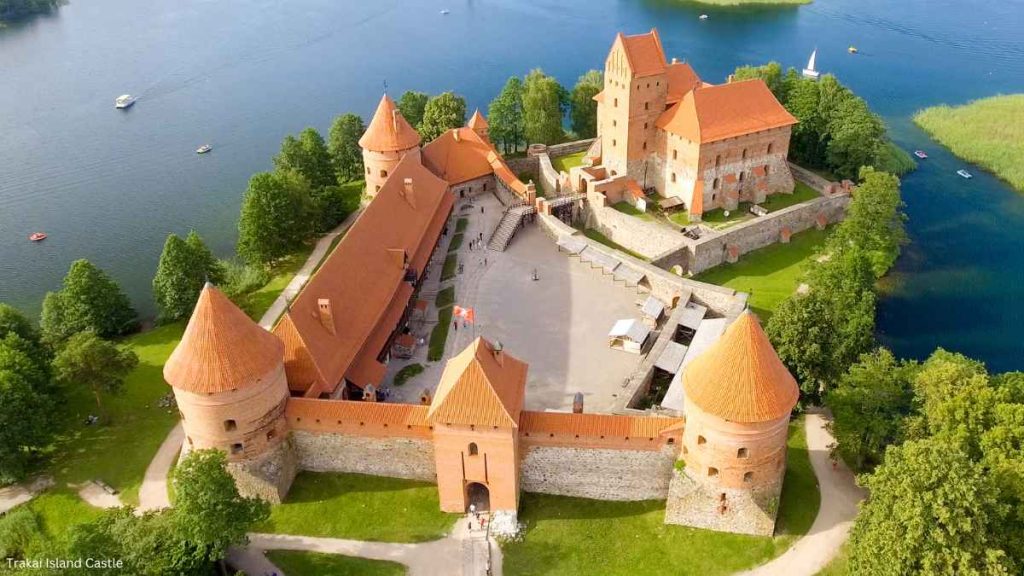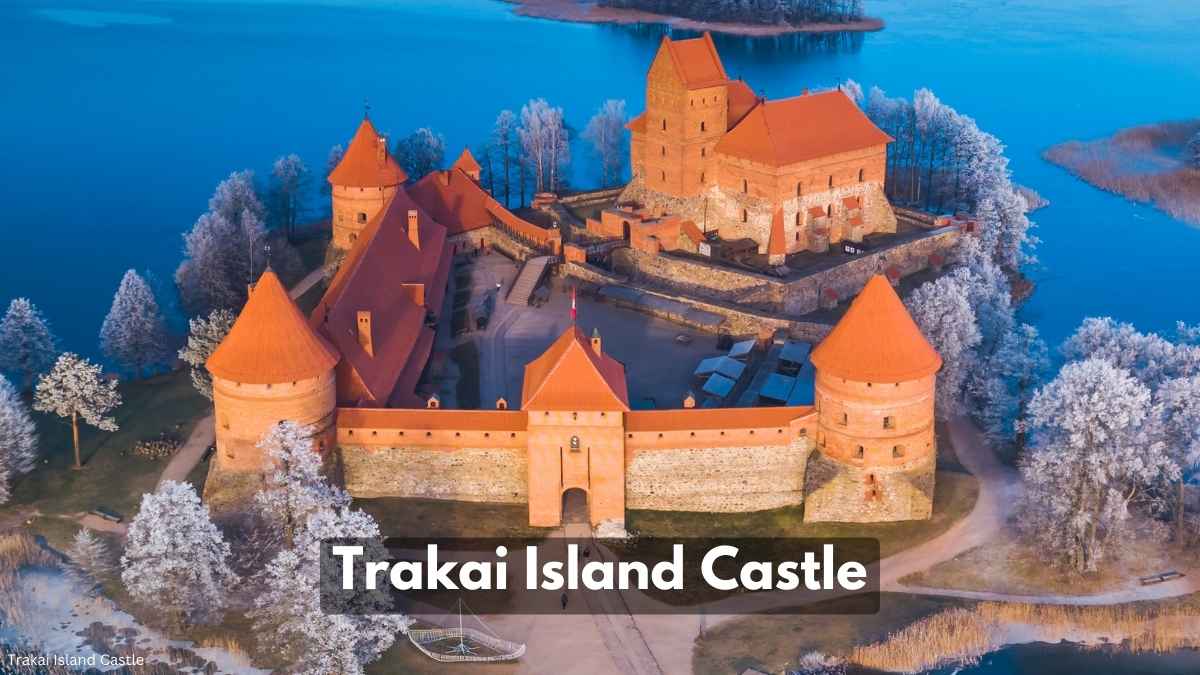Trakai Island Castle, a magnificent historical landmark, holds a significant place in the rich tapestry of Lithuania’s past. Situated on an island amidst the picturesque Lake Galvė, this medieval fortress stands as a testament to the region’s grandeur and strategic importance. With its origins dating back to the 14th century, Trakai Island Castle was constructed by the Grand Duke of Lithuania, Gediminas, and his successors. The castle served as a vital defensive stronghold, safeguarding the Grand Duchy against potential invaders.
Its strategic location on an island surrounded by water added an extra layer of protection, making it an imposing fortress in its time. Throughout history, Trakai Island Castle witnessed various significant events, including the power struggles between rival factions and battles against invading forces. Despite experiencing periods of decline and neglect, dedicated restoration efforts have preserved this architectural gem, enabling present-day visitors to marvel at its splendor and immerse themselves in the historical wonders of the Grand Duchy.
Table of Contents
Historical Background
A. Overview of the region and its importance
Trakai Island Castle is situated in the historic region of Trakai, located in present-day Lithuania. Trakai, known for its picturesque landscape of lakes and forests, played a crucial role in the formation and expansion of the Grand Duchy of Lithuania during the medieval period. The region’s strategic location allowed it to become a center of trade, culture, and political power.
B. Founding and construction of Trakai Island Castle
Trakai Island Castle’s construction began in the 14th century under the rule of Gediminas, the Grand Duke of Lithuania. The castle was built on an island in Lake Galvė, providing it with natural defenses and making it a formidable fortress. Over time, subsequent rulers, including Vytautas the Great, further expanded and fortified the castle, adding defensive walls and towers to strengthen its military capabilities.
C. Key events and rulers associated with the castle
Throughout its history, Trakai Island Castle witnessed significant events and hosted several notable rulers. In the early 15th century, under Vytautas the Great, the castle reached its peak of influence and power. Vytautas, one of the most prominent rulers of Lithuania, used the castle as his main residence and administrative center. The castle played a crucial role in various military campaigns, including the Battle of Grunwald in 1410, where Vytautas and the Polish forces achieved a decisive victory against the Teutonic Knights.
Moreover, Trakai Island Castle also became a symbol of multiculturalism during its peak, as it was a residence for the Grand Dukes and their families, who married into noble families from different ethnic backgrounds.
The history of Trakai Island Castle is intertwined with the rise and fall of the Grand Duchy of Lithuania, and it continues to stand as a symbol of the region’s historical and cultural significance.

Architectural Features
A. Description of the castle’s location and setting on an island
Trakai Island Castle is perched on a small island in the middle of Lake Galvė, surrounded by breathtaking natural beauty. The picturesque location not only provided a stunning backdrop but also served as a strategic advantage, making the castle challenging to approach for potential invaders. The island’s proximity to the mainland allowed for easy communication and transportation, making it an ideal location for a defensive fortress.
B. Layout and design of the castle’s structures
1. Main defensive walls and towers
The castle’s core features massive defensive walls, constructed from sturdy stone, and fortified with robust towers at strategic points. These walls acted as the primary line of defense, protecting the inhabitants and providing vantage points for archers and defenders.
2. Courtyards and inner buildings
Inside the walls, Trakai Island Castle comprises multiple courtyards, each serving specific purposes. The main courtyard housed the residence of the Grand Duke and the ruling elite, while others accommodated military personnel and administrative offices. The buildings were constructed with timber and brick, showcasing a blend of architectural styles from different periods.
3. Drawbridges and water defenses
The castle’s entrance was secured by a drawbridge, which could be raised to prevent access during times of danger. Surrounding the island, an intricate system of water defenses, including wooden palisades and underwater barricades, further enhanced the castle’s security.
C. Evolution of the castle’s architecture over time
Trakai Island Castle underwent several expansions and renovations throughout its history. Initially built as a wooden fortress, it evolved into a robust stone structure under Vytautas the Great’s rule. Subsequent rulers, including Sigismund Augustus, made further modifications, transitioning some of the wooden structures to stone and adding more elements to accommodate changing military tactics and technologies.
The architectural evolution of Trakai Island Castle reflects the region’s dynamic history, from a wooden stronghold to a mighty stone fortress.
Role in History
A. Use as a defensive stronghold
Trakai Island Castle played a pivotal role as a defensive stronghold during the medieval era. Positioned on an island, it presented a formidable challenge for invading forces due to the natural water defenses and the strong fortifications. The castle successfully withstood numerous sieges and attacks, testifying to its defensive prowess.
B. Military significance and strategic importance
The castle’s strategic location within the Grand Duchy of Lithuania made it a central point for military operations and governance. It served as a base for military campaigns, allowing the Grand Dukes to exert their authority over the territory and defend against external threats.
C. Connection to the Grand Duchy of Lithuania
Trakai Island Castle served as the residence of Lithuanian Grand Dukes, including Vytautas the Great, who made it their primary residence and administrative center. The castle’s prominence reflects the importance of Trakai within the Grand Duchy and its role as a center of political power and cultural exchange.
Notable Events and People
A. Famous battles or sieges involving the castle
The castle witnessed several notable battles and sieges throughout history. One of the most significant events was the Battle of Grunwald in 1410, where Vytautas the Great led the Lithuanian and Polish forces to a decisive victory against the Teutonic Knights. The castle’s strategic significance during this battle played a crucial role in the outcome of the conflict.
B. Prominent historical figures associated with Trakai Island Castle
Trakai Island Castle was closely connected to prominent historical figures, including Vytautas the Great and other Lithuanian Grand Dukes. These rulers used the castle as their residence and center of power, leaving a lasting impact on its development and significance.
Decline and Restoration
A. Factors leading to the castle’s decline
Over time, as the political landscape shifted and the borders of the Grand Duchy of Lithuania changed, the significance of Trakai Island Castle diminished. Changes in military tactics and the rise of more modern fortresses also contributed to its decline.
B. Abandonment and deterioration
During the 17th and 18th centuries, the castle began to fall into disrepair. It was no longer actively used as a residence or military stronghold, and its neglected state led to gradual deterioration.
C. Efforts and initiatives for restoration
In the 19th and 20th centuries, renewed interest in Lithuania’s historical heritage led to efforts to restore Trakai Island Castle. Significant restoration work took place, focusing on preserving its original features and showcasing its architectural splendor.
Present-Day Trakai Island Castle
A. Current state and condition of the castle
Today, Trakai Island Castle stands proudly as a well-preserved monument, giving visitors a glimpse into Lithuania’s medieval past. The restoration efforts have ensured that the castle remains an essential part of the nation’s cultural heritage.
B. Role as a historical site and tourist attraction
Trakai Island Castle has become a major tourist attraction, drawing visitors from all over the world. Its picturesque setting, rich history, and architectural beauty make it a captivating destination for history enthusiasts and travelers alike.
C. Activities and events hosted at the castle today
The castle now serves as a venue for various cultural events, exhibitions, and festivals, offering visitors a chance to immerse themselves in the traditions and history of the region.
Conclusion
A. Recap of Trakai Island Castle’s historical and architectural significance
Trakai Island Castle stands as a symbol of Lithuania’s medieval heritage, showcasing the architectural brilliance of its time and the military strength it once represented.
B. Importance as a cultural heritage site
As a cultural heritage site, the castle embodies the shared history and identity of the Lithuanian people, fostering a sense of national pride and unity.
C. Final thoughts on its enduring legacy
The enduring legacy of Trakai Island Castle lies in its ability to transport visitors through time, offering a glimpse into a fascinating period of Lithuania’s history and leaving a lasting impression on all who explore its storied grounds.
You May Also Like:
Malbork Castle: Europe’s Largest Gothic Fortress
Himeji Castle: A Real Life Samurai Stronghold Frozen in History




Leave a Reply